Long distance binoculars with sturdy casing and design.
If you are looking for the best binoculars for long distance, this article will be useful for you to read. Here you will find both budget-friendly and more expensive options, binoculars that are aimed at bird-watching, hunting, and other activities.
If you barely understand what features affect the effectiveness of the long distance binoculars, I highly recommend you read till the end and you’ll figure out what specs to pay attention to while making a choice.
The initial idea behind creating the binoculars is to bring clarity to your outdoor experiences, but when it comes to selecting the best binoculars for long distance, things get really confusing. The surest way to get an appropriate pair of binoculars is to go to a specialized store and look through several variants to decide which suits you best.
However, in the era of online shopping, many people get the necessary item via the Internet. That’s why, it is important to know what products worth paying attention to before making a purchase. The overview below is meant to help you with your choice.
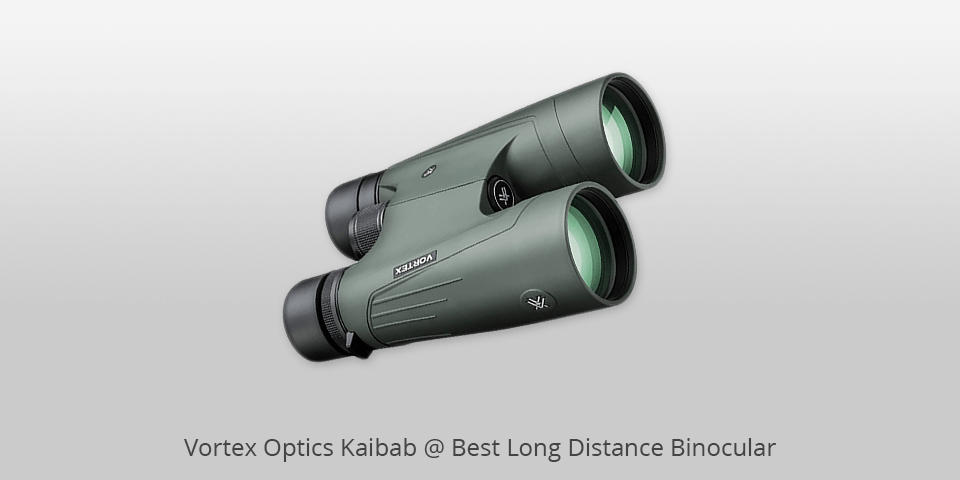
Magnification: 18 x | Objective diameter: 56 mm | Field of view at 1000m: 60 | Closest focusing distance: 6| Eye relief:16.4 mm | Weight: 1200 g
⊕ Compact roof prism
⊕ Amazing color accuracy
⊕ Broad focus range
⊕ Small weight, long-lasting case
⊖ Disappointing exit pupil and FOV
⊖ Slight edge distortion
Kaibab HD is one of the best binoculars for long distance viewing thanks to high-magnification optical performance, APO optical system, and high density, extra-low dispersion lenses. They are made of qualitative materials, so will serve you for many years.
To enjoy the full power of this pair of binoculars, you need to add a tripod to the setup. The lenses used in this model are multi-coated, with XR and capable of eliminating reflections. Thanks to these characteristics, you will see crisp objects with true-to-life colors.
Regardless of the conditions you use these binoculars in, you can be sure they are kept protected due to durable, non-slip rubber armor and ultra-hard ARMORTEK lens coating.
The binoculars have a precise focus wheel that ensures the image you see is smooth and accurate. A right-eye diopter locks down to provide the best focus. If needed, you can customize the eyecups the way you want.
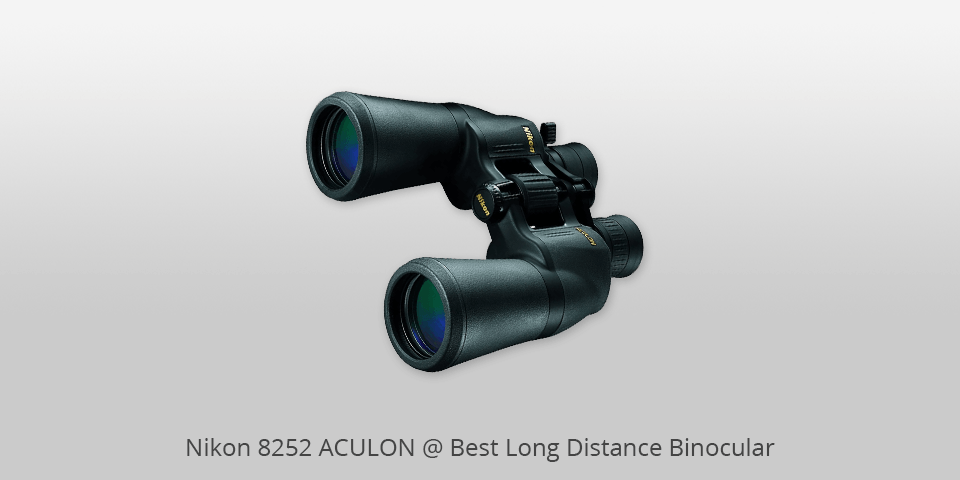
Magnification: 22x | Objective diameter: 50 mm | Field of view at 1000m: 66 | Closest focusing distance: 15 meter | Eye relief: 11.8 mm | Weight: 907 g
⊕ Easily customizable magnification range
⊕ Amazing performance in good lighting
⊕ Perfect non-slip grip
⊕ Comes with eyecups
⊖ Minimum power of 10
⊖ No protection from moisture
Being very long distance binoculars, ACULON A211 don’t weigh much and can satisfy those buyers, who need a model they can easily fit in a regular bag. The well-thought-out design is another advantage, allowing users to reach the necessary buttons with ease.
There is a special Fingertip Zoom Control Know, which is intended for fast adjustment of the magnification power in the range from 10 to 22. You can also customize the interpupillary distance from 56-72mm.
These binoculars are supplied with turn and slide rubber eyecups, which ensure comfortable viewing for 30+minutes. The minimum focus distance is 49.2 feet.
If you value durability and want to use the farthest seeing binoculars in unfavorable weather conditions, ACULON A211 seems to be a nice option thanks to the durable rubber armored coating, which also provides tight grip.
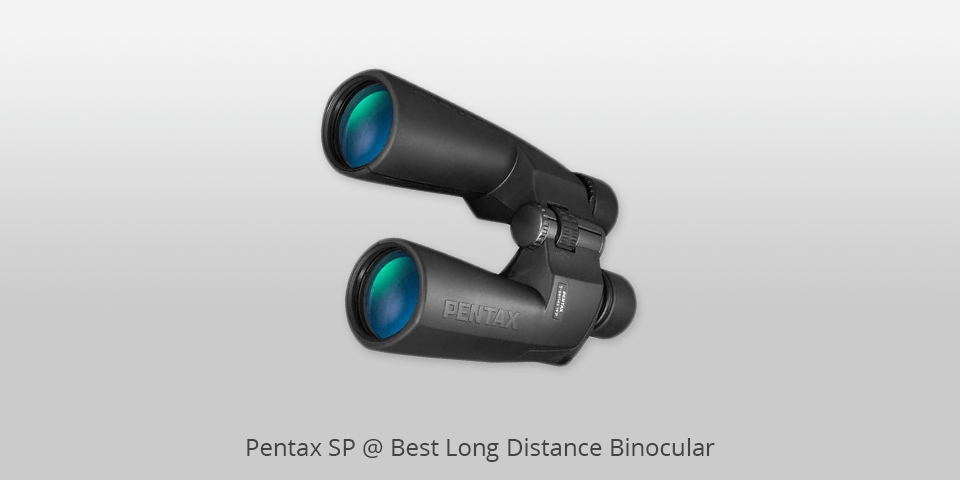
Magnification: 20x | Objective diameter: 50 mm | Field of view at 1000m: 87 m| Closest focusing distance: 0.2m | Eye relief: 20 mm | Weight: 1360 g
⊕ Premium-looking and fully watertight housing
⊕ Amazing color rendering
⊕ BaK-4 glass prism
⊕ Almost no deterioration
⊖ Disappointing sharpness on edges
⊖ A bit truncated exit pupils
Pentax SP can be called the best long range binoculars since it fully corresponds to the demands made by consumers. They have big objective lens elements, which allows a huge amount of light to get inside and showed off absolutely well in poor lighting conditions. The top-tier multi later coating adds to the light transmission, which altogether results in sharp and accurate images.
The SP model can’t boast a special coating that is aimed at protecting optics from dust, moisture and grease, but you can choose the product from the SD line-up developed by this manufacturer if that’s really important to you.
Actually, these binoculars for long distance viewing can satisfy the vast majority of buyers, whose main priorities are durable construction, quality optics and convenient operation.
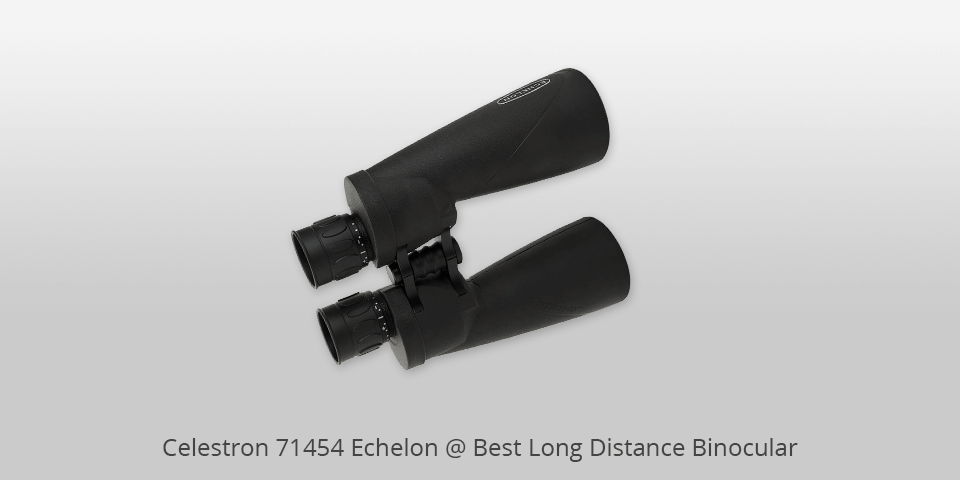
Magnification: 20x | Objective diameter: 32 mm | Field of view at 1000m: 157 metres | Closest focusing distance: 0.45m | Eye relief: 19.5 mm | Weight: 1815 g
⊕ Decent work in poor light
⊕ Great watertight design
⊕ Hand-assembled in the US
⊖ High price
These are the best long distance binoculars if you intend to use them in poor lighting conditions. The large 70mm aperture and 3.5mm exit pupil make it possible to see tiny details placed in shadowed areas. This makes them ideal for astronomy. If you need binoculars that will work smoothly even in high humidity regions, you should opt for this product.
The main components of the construction are made in Japan and hand-assembled in the USA with the implementation of Celestron’s proprietary XLT coating technology. Thus, these binoculars are expected to serve you for many years to come. They can be also mounted on a tripod, if you are planning long observing sessions.
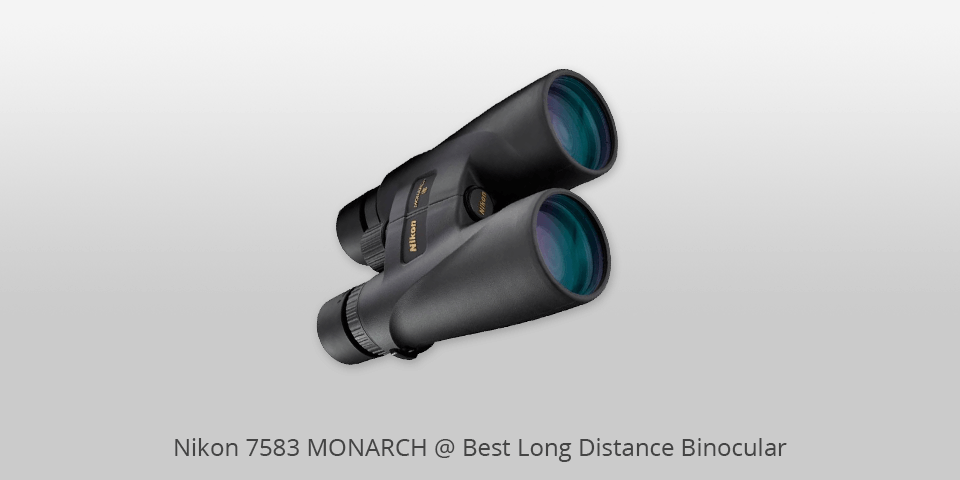
Magnification: 20 x | Objective diameter: 56 mm| Field of view at 1000m: 145m | Closest focusing distance: 16.4 ft.| Eye relief: 16.4 mm | Weight: 1200 g
⊕ Wonderful brightness and clarity
⊕ Smooth focus knob
⊖ Poor close focus range
⊖ Mediocre FOV
Nikon did their best to create binoculars for distance and clarity that can satisfy the pickiest buyer. They have a rubber coating, which protects the filling and makes holding the product absolutely convenient. The smooth focus knob adds flexibility to the operation, which is especially important if you use them during hunting.
Similar to other representatives of the MONARCH series, these binoculars also come with the legendary ED (extra-low dispersion) lenses, which fix chromatic aberrations and compensate for color fringing. Unfortunately, the company didn’t pay enough attention to the close focus range and the field of few, and both these characteristics are disappointing.
Anyway, the dielectric high-reflective multilayer prism coating applied to all lenses help deal with contrast issues and handle possible problems with color rendition.
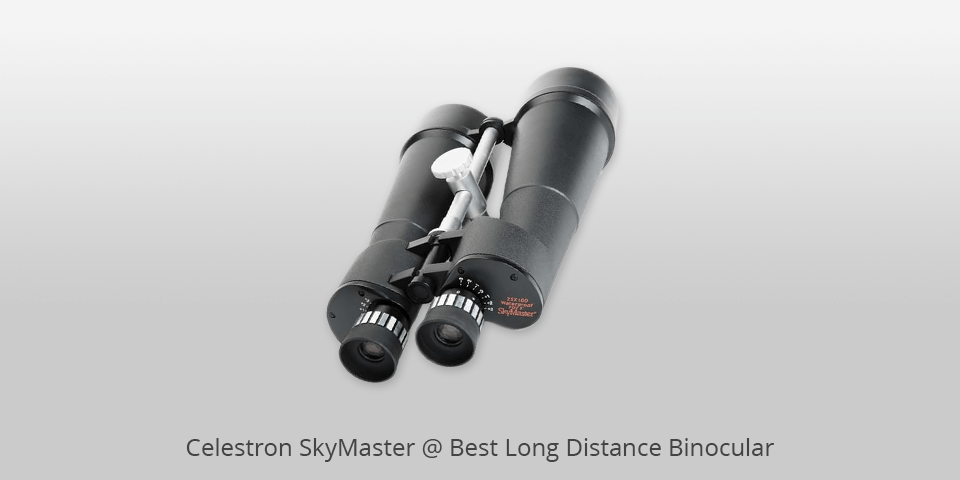
Magnification: 25x | Objective diameter: 70 mm | Field of view at 1000m: 77 m | Closest focusing distance: 75 m | Eye relief: 18 mm | Weight: 4080 g
⊕ Robust 25x magnification
⊕ Comes with a tripod adapter
⊕ Reliable, waterproof
⊖ Weighs a lot
Celestron SkyMaster binoculars are the best binoculars for long distance with the size of 25x100, large 100mm objective lenses, and the biggest aperture possible. If you are looking for astronomy binoculars, this will be the best option for you. The model comes with a photo tripod adapter that provides hands-free use and portability for more convenient sky-observing.
These long distance binoculars are popular among people who like using them at dim lighting, for instance, during the sunset or sunrise or for astronomy goals. Due to the BaK-4 prisms, these binoculars provide great light transmission and guarantee the vivid and sharp quality of the image.
The exit pupil of these binoculars is 0.16 inches. Their rugged, armored body creates a secure gripping surface, which is why these binoculars are very durable. They are waterproof so nothing will happen to them if you accidentally get under the rain.
This is a leading binoculars brand and manufacturer, which has been located in California since 1960, so you can purchase these binoculars without any doubt. Besides, if you buy them, you will get Limited Lifetime warranty and unlimited access to customer support from the team of US-based professionals.
| Image | Name | Features | |
|---|---|---|---|
 |
Vortex Optics Kaibab
Our choice |
CHECK PRICE → | |
 |
Nikon 8252 ACULON
High quality |
CHECK PRICE → | |
 |
Pentax SP
Stylish |
CHECK PRICE → |

The number that is put before an “x” in the description of binoculars means magnification or how close you will see the objects. If you need binoculars for regular use, not for a specific activity, choose binoculars with magnification from 7x to 10x. They will provide a good magnification for the majority of activities and will be stable if your hand is shaky.
Binoculars are indicated by two numbers, like 7x35 or 10x50. The second number implies the diameter of the main (objective) lenses in millimeters. 7x35 lenses have a diameter of 35 mm (1.38 inches). 10x50 lenses have a diameter of 50 mm (1.97 inches).
Binoculars with quite small magnification parameters produce images with a lower magnification than binoculars with larger magnification parameters. Images provided by such binoculars are sharper, and the field of view (how wide you can see) is wider. If you are looking for a wide field of view in binoculars, for example, to watch a football match from high seats, select a lower magnification.
If you want binoculars for a particular primary purpose, like bird and whale watching, or astronomy, check the basic guidelines described below. With their help, you will be able to easily choose the best binoculars for long distance viewing. Magnification and size are the main characteristics. Also, you need to consider optics and specifications while selecting binoculars.
Binoculars for backpacking and hiking. As the size and weight in your backpack are the main issues, you need compact binoculars with 8x or 10x magnification and a lens with a diameter of less than 28 (8x25, 10x25, 8x28 and 10x28 would be perfect.). Binoculars with a rubber coating will be more long-lasting. Waterproof ones will help you see everything in bad weather conditions without any impact.
Binoculars for birding. If you're less worried about size and weight, you can opt for medium and full-sized binoculars. 8x32 and 8x42 models are widely used by birders. Although 10x magnification may seem great when watching a small animal, models with 8x magnification will be the best binoculars for long distance for this purpose as they will have a wider field of view, which is required for watching birds. Waterproof and fog-proof binoculars are also great as they won’t give you inconveniences in poor weather conditions.
Binoculars for whale watching, wildlife viewing, and safaris. Among widely-used models, you can find 8x32, 8x42, 10x32, and 10x42. Opt for a large magnification (10x instead of 8x) when you are going to be far from animals. Select medium (32 mm objective lens) instead of full size (42 mm lens) if you want more compact binoculars. Waterproof properties are obviously a benefit for watching whales from a boat, not from the shore.
Binoculars for paddling. If you intend to be on the water on a canoe, kayak, SUP, or whale-watching boat, choose long range observation binoculars with a smaller magnification, like 8x or less as a higher (10x) magnification can make steady viewing quite difficult. Selecting a waterproof model is also a great idea and you can understand why. 8x32 is a frequently-used size for such binoculars.
Binoculars for stargazing. For this purpose, you need binoculars with maximum magnification and the ability to collect light. 10x42 or 10x50 are the best variants. If you select a model with higher magnification, you will need a tripod to keep the binoculars steady.

The quality of the image is very important. How vivid are the bins? How sharp are they? How realistic are the colors? How well do they show details if the image is backlit? The majority of optics stores are better lit than a regular forest, so find some dark place to compare the performance in low light. Pay particular attention to the Clarity and Crispness indicators to decide on the quality of the image. Remember that due to poor image quality, I don’t advise using compact binoculars with lenses of less than 30 mm.
WHAT TO PAY ATTENTION TO Magnification. The binocular magnification is the number that stands before the “x”. The Diameter of Objective Lens. The Quality of Lens, Coating. Field of View, Exit Pupil. Weight and Eye Strain. Water Resistance. Set of Features for Particular Purposes.
If you need binoculars for regular use, and not for a particular purpose, opt for binoculars with 7x to 10x magnification. Such binoculars will provide good magnification for the majority of purposes and keep everything stable if your hand is shaking. Binoculars are indicated by 2 numbers, like 7x35 or 10x50.
Usually, the smallest magnification that provides a clear image is the best one. I use 4x rifle scopes for big-game hunting, and I think it’s enough for 300 yards. 6x magnification works great for me at 400. You will definitely need a larger magnification to observe small animals, such as prairie dogs.
It’s up to you whether to use 8x or 10x binoculars. Usually, 10x models are better for watching birds at distance. However, it also means that you will have a narrow field of view, a bit darker image in low light, and a more visible hand-shake.

 Rating
Rating